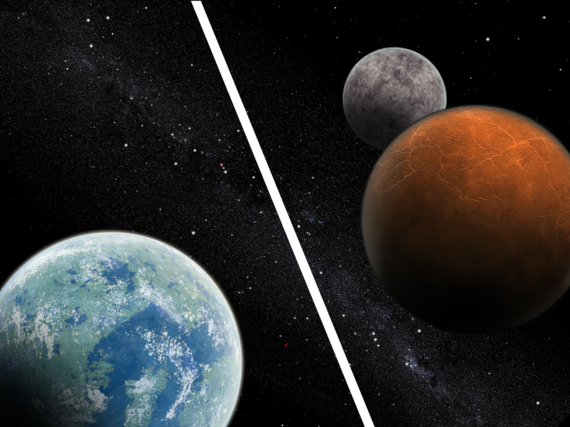Image credit: Hanno Rein
"Do you think we could be easily misled by an exo-Moon?" my colleague and friend Hanno Rein, astronomy professor at the University of Toronto, had just texted me from Toronto as I was on a train from Zurich to Paris. "Suppose the planet has a lot of oxygen and the moon a lot of methane," he continued. "If you can't resolve the bodies it might look like disequilibrium chemistry."
I immediately realized he was right, and his insight was important. After a rapid-fire exchange of texts, we hashed out a plan to model this type of system and see whether a planet-moon pair could spoof signs of life, and we invited Yuka Fujii, a friend and colleague of ours who had previously done similar modeling work, to join our effort.
(Modern life is amazing, by the way: In the span of 20 minutes, a German in Canada, a Japanese woman who was in New Jersey, and an American traveling from Switzerland to France planned a scientific project by text message.)
* * *
The question of whether we are alone in the Universe is one of the most compelling sources of human wonder and has driven my own motivation to study astrophysics. It's easy to speculate, as people have done for millennia, about the size of the Universe (infinite? finite but huge?), the number of potential abodes, and the likelihood of life arising, given hospitable conditions -- all of which, of course, affects how much life there is in our universe. But speculation isn't science.
A couple of decades ago, worlds orbiting stars other than our Sun were first discovered. These objects are referred to as "extrasolar planets," or "exoplanets" for short. The pace of discovery was slow at first but has accelerated remarkably. As we've moved from nine known planets in our solar system and none beyond it to now eight in our solar system (condolences to Pluto) and more than a thousand beyond, the question of how much life there is in our galaxy and in our universe has come tantalizingly closer to the realm of empirical testability.
But how would we test it? How could we find aliens?
If inhabitants of other planets aren't so kind as to announce their presence via directed radio signals, such as in the movie Contact, we'll have to look for evidence of a biosphere. The catchphrase for the type of evidence we'd seek is "biosignatures," which means spectral indications of chemicals, or combinations of chemicals, that could arise from life and could not (or would be very unlikely to) arise without life.
What would be a good biosignature? An appealing idea is water, since all life on Earth depends on water. But although water might be necessary for life, it can certainly exist without life, as there is water on Mars, Jupiter, and even Mercury (in trace amounts), among other (as far as is know) lifeless objects in the Solar System. Better ideas for biosignatures include combinations of chemicals that are out of chemical equilibrium, since life produces disequilibrium chemistry. Alas, all planetary atmospheres in our solar system are, to some degree, out of chemical equilibrium. Finding a robust biosignature is not obvious.
It has long been thought that the combination of a strongly oxidizing gas (such as molecular oxygen) and a gas that is easily oxidized (such as methane) would produce a situation so far from equilibrium that the less-abundant gas would very quickly be entirely depleted if it weren't continuously replenished by life. With this in mind, Carl Sagan suggested that seeing detectable levels of oxygen and methane, together in the same atmosphere, could be the smoking-gun sign of life that we hope to find on an exoplanet.
* * *
For our paper in the Proceedings of the National Academy of Sciences, Hanno, Yuka, and I modeled two scenarios: a planet (kind of like the Earth) with both oxygen and methane in its atmosphere, and a planet-moon system where the planet had oxygen and the moon -- like Saturn's moon Titan -- had methane. We found that the spectra from these two scenarios can be distinguished, but only with much higher-resolution spectroscopy than we will be able to obtain from exoplanets in the foreseeable future.
In other words, for decades, at least, astronomers will be unable to know that an Earth twin's spectrum that shows signs of both oxygen and methane comes entirely from a single object. In other words, even if we find such a tantalizing signal, we might not know that we've found life on the Earth twin.
I say "might not," because there's still a bit of wiggle room. For one thing, maybe seeing methane is unnecessary; chemists might assure us that seeing abundant levels of oxygen alone is a sure sign of life. For another, we might develop confidence on theoretical grounds that a moon could not hold on to a methane-rich atmosphere if it were as close to its star as the Earth is to the Sun. Absent these types of advances, though, we won't be able to rule out an abiological explanation of an oxygen-and-methane signal.
This conclusion might sound disappointing, but it just points toward interesting directions for further research. Hopefully, our work will help inspire some other scientists (perhaps while texting during train transit!) to have further ideas that advance our progress toward identifying life beyond Earth.
